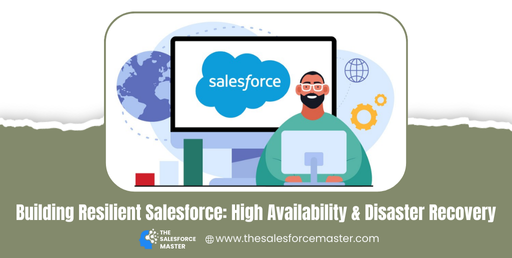
Building Resilient Salesforce: High Availability & Disaster Recovery
Salesforce is a cornerstone for many businesses. Ensuring its high availability and robust disaster recovery is crucial. Implementing these strategies can significantly impact your business continuity and customer satisfaction. Let’s explore how to build a resilient Salesforce environment.
Ensuring High Availability
High availability means your Salesforce environment is accessible at all times. Downtime can disrupt operations and reduce customer trust. Here are key strategies:
1. Redundant Infrastructure: Utilize redundant systems to ensure continuous operation. If one component fails, another can take over. This setup minimizes downtime and ensures seamless performance.
2. Load Balancing: Distribute workloads across multiple servers. Load balancing prevents any single server from becoming a bottleneck. It enhances performance and ensures high availability.
3. Regular Maintenance and Updates: Keep your Salesforce environment updated. Regular maintenance ensures all components function optimally. Updated systems are less prone to failures and security threats.
4. Salesforce Shield: Use Salesforce Shield for enhanced security and monitoring. It provides encryption, event monitoring, and field audit trail. These features protect your data and ensure compliance.
5. Reliable Internet Connection: Ensure a robust internet connection. A stable connection is vital for uninterrupted Salesforce access. Consider multiple internet providers for redundancy.
Effective Disaster Recovery Planning
Disaster recovery plans are essential for any Salesforce environment. They prepare you for unexpected events that could disrupt your operations. Here’s how to create an effective plan:
1. Data Backup: Regularly back up your Salesforce data. Use Salesforce’s built-in tools or third-party solutions. Ensure backups are stored in multiple locations to avoid data loss.
2. Recovery Time Objectives (RTO) and Recovery Point Objectives (RPO): Define RTO and RPO for your Salesforce environment. RTO is the maximum acceptable downtime. RPO is the maximum acceptable data loss. These metrics guide your recovery strategies.
3. Testing and Drills: Regularly test your disaster recovery plan. Conduct drills to ensure your team knows their roles. Testing identifies potential issues and improves your response time.
4. Communication Plan: Develop a communication plan for disaster scenarios. Ensure all stakeholders know their roles and responsibilities. Clear communication minimizes confusion and speeds up recovery.
5. Third-Party Integrations: Consider your third-party integrations in your recovery plan. Ensure these integrations are also backed up and can be restored quickly.
Leveraging Salesforce Marketer for Continuity
Salesforce Marketer tools can enhance your high availability and disaster recovery efforts. They streamline communication, data management, and customer engagement. Here’s how:
1. Journey Builder: Use Journey Builder to automate customer interactions. It ensures consistent communication even during disruptions.
2. Marketing Cloud Connect: Integrate Salesforce Marketer with other Salesforce clouds. This integration ensures data consistency across platforms.
3. Email Studio: Use Email Studio to keep customers informed during disruptions. Timely updates can enhance customer trust.
4. Social Studio: Monitor social media for customer concerns. Social Studio helps manage your brand’s reputation during crises.
5. Advertising Studio: Maintain your advertising efforts during disruptions. Advertising Studio ensures your campaigns continue to reach your audience.
6. Mobile Studio: Keep mobile communications active with Mobile Studio. It helps you reach customers on their preferred devices.
7. Data Management Platform (DMP): Use DMP to manage customer data effectively. It ensures data integrity and enhances recovery efforts.
8. Einstein Analytics: Leverage Einstein Analytics for real-time insights. It helps identify issues and streamline recovery processes.
9. Salesforce Datorama: Use Datorama for comprehensive marketing data analysis. It provides a unified view of your marketing efforts.
10. Pardot: Utilize Pardot for B2B marketing automation. It ensures seamless lead management during disruptions.
Building a resilient Salesforce environment involves strategic planning and continuous improvement. High availability and effective disaster recovery plans are critical. By leveraging Salesforce Marketer tools, you can enhance these efforts and ensure business continuity.
This proactive approach safeguards your operations and maintains customer trust. Your Salesforce environment will be robust, reliable, and ready to handle any challenge.


